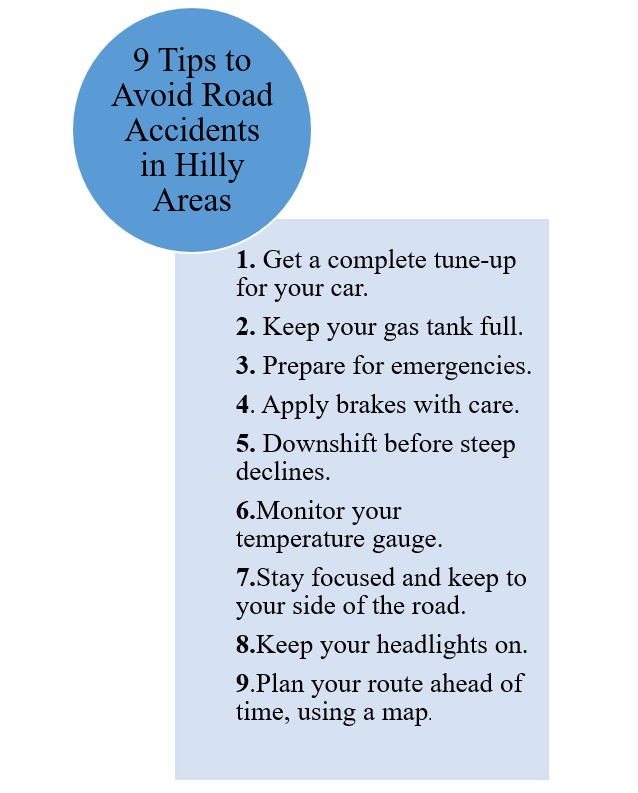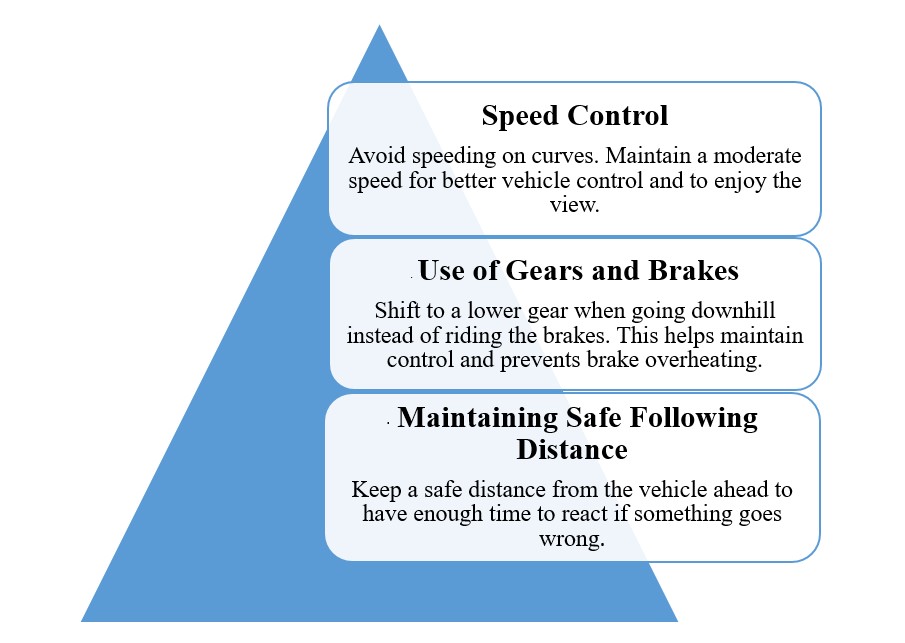Mountain driving is different from driving in flat lands.
In hilly regions, there will be a number of curves and hairpin bends. However, accident rates and death rates in hilly regions are increasing day by day.
It can be an exciting experience to drive through Pakistan’s hilly regions, such as Murree, Swat, and the Karakoram Highway etc.
But if the right safety measures aren’t followed, the thrill of these travels can rapidly turn into a nightmare.
The roads in this region will certainly have curves and sharp turns, so it is hard to see the vehicle coming from the opposite side.
So, driving in hilly areas can be thrilling, but it’s also risky if you’re not prepared.
As someone said
“It’s not the mountain we conquer, but ourselves.”
This quote by Sir Edmund Hillary, the first person to summit Mount Everest, perfectly sums up the mindset needed for driving in hilly areas.
Imagine You’re driving up a winding mountain road, the sun is setting, and the view is absolutely breathtaking. But suddenly, the road gets steeper, the turns sharper, and you realize that this isn’t just any drive, it’s a challenge.
It’s all about preparation, control, and a good dose of respect for the terrain. Let’s talk about how you can enjoy these beautiful routes safely.
Some Tragedies Occurs in Hilly Areas
Murree Tragedy (2022)
A shocking accident in Murree during a snowstorm claimed the lives of over 20 tourists.
The main causes of this tragedy are:
- Overloading
- lack of vehicle maintenance
- Poor weather conditions
This tragedy taught us the importance of avoiding travel during severe weather and our vehicle is equipped for the journey.
Karakoram Highway Incident (2019)
In 2019, a bus rushed into a ravine on the Karakoram Highway due to brake failure.
This incident emphasizes the necessity of regular brake checks and driving cautiously on steep hills.
9 Safety Tips to Avoid Road Accidents in Hilly Areas

Road safety is an issue of national concern. Road traffic accidents (RTA) are responsible for 1.2 million deaths worldwide each year.
We’ve compiled nine useful recommendations that can lower your chance of an accident when driving in hilly or mountainous terrain to help you stay safe.
1. Get a Complete Tune-Up
Your car could require extra care before a journey into steep terrain, particularly during the chilly months of winter.
Make sure the transmission and brake fluids on the car are full. Verify the functionality of the exhaust, heating and cooling, and wipers on the windshield, battery, and brake systems.
A spare tire should be ready to go, and the tires should be inflated as well. Because of unexpected circumstances, rough terrain, and inclement weather, your car should be in top shape.
2. Keep your Gas Tank Full
Many people don’t realize that climbing steep grades requires more fuel than the typical drive.
You can almost guarantee a breakdown if you combine that with the possibility of limited gas outlets and cell phone reception in mountainous places.
A driver who runs out of petrol runs a considerable risk of being struck by another vehicle because many mountain routes have narrow shoulders and poor sight.
However, if you want to take a beautiful mountain trip, fill up your car to the top before you go.
3. Prepare for Emergencies
Sudden bad weather or a car accident could leave you stuck in mountain areas.
Before you leave, inform someone of your destination and expected arrival time. Pack extra food, water, clothing, first aid, and tools for minor repairs in case roadside assistance isn’t available.
4. Apply Brakes with Care
Continuous braking on steep grades can overheat your brakes. Use the tap method (quick, light taps on the brake pedal) to keep them cool.
Brake before steep, hairpin turns to shift the forces to the back of the car, giving you better control and allowing for smoother drifting through winding roads.
5. Downshift Before Steep Declines
Shift into a lower gear for even better performance on difficult terrain. This will help you manage your speed and lessen the strain on the brakes and engine of your car.
This should be done before you go downhill, as changing gears on a steep incline might be risky.
6. Monitor your Temperature Gauge
Make sure the engine temperature indicator is in the safe range as you climb.
If you notice it rising above the permitted level, turn off the air conditioning and go lighter on the accelerator.
On the other hand, stop where it’s safe to do so and enjoy the scenery while the engine cools down.
7. Stay Focused and Keep to your Side of the Road
Focus on maintaining a consistent spacing between the yellow lines while driving.
Drifting into oncoming traffic, even for a moment, can lead to an accident.
If there are more than two or three cars following you, let them pass at the next authorized pullout. Use roadside pullouts for attractive stops.
Take note of the right-of-way for traffic moving uphill, and keep an eye out for sudden changes in the terrain, such as hairpin curves and high cliffs.
8. Keep your Headlights On
Use headlights in dusk, dawn, rain, snow, fog, and at night to stay visible. Ensure your headlights are working properly and free of debris before driving.
9. Plan your Route ahead of Time
Relying on your smartphone’s GPS app may get you wherever you need to go without a hitch in urban areas, but these apps tend to struggle in remote areas where small side roads may not be mapped completely or accurately.
To avoid a wrong turn, plot out your trip on an old-fashioned paper map before you depart; even if your smartphone handles the job just fine, you’ll feel better knowing you have a backup on hand.
When driving on mountain roads, your most important considerations are:
- Vehicle condition: your brakes, steering, suspension, and cooling systems must be in good condition.
- Speed: your speed should not be too fast for road and weather conditions. Also, you should be able to maintain a safe speed on winding mountain roads.
Pre-Trip Preparation
There are some preliminaries to be done before you even go on the road. Consider it as preparing for an adventure where your utmost concern is safety.

Mountain roads aren’t your average highways. They twist, turn, rise, and fall in ways that can be both exhilarating and challenging.
- Familiarizing Yourself with the Route: Combine GPS with a paper map to understand the terrain, including sharp turns and steep inclines, before you encounter them.
- Navigating Curves and Turns: Slow down before curves, and avoid overtaking on blind corners.
Safe Driving Practices
Now that you’re on the road, let’s talk about how to keep things safe and smooth.

Handling Adverse Weather Conditions
Driving on mountains and hills is dangerous, regardless of the time of year or type of weather.
Weather in the mountains can be unpredictable. One minute it’s sunny, and the next, you’re driving through fog.
Keep a few handy tips in mind to help with navigating those winding, steep roads.
Driving in Rain, Fog, or Snow
- If there’s a possibility of snow, take along chains, a de-icer for your windshield and windows, an ice scraper, a snow brush, a flashlight, and a hand shovel. Only use chains on snow or ice—remove them if the road has been cleared so they don’t damage your tires or the road.
- Make sure you have plenty of gas. If there are delays, it’s best to keep your car running.
- Drive slower. This may seem obvious, but there are drivers that seem to think that normal speeds are acceptable in bad weather. Let heavy-footed drivers pass you.
- If your car stalls, stay with it. A car is easier to see than a pedestrian. It’s also safer to stay inside the car.
Driving in Normal Weather
- Shift to a lower gear on steep inclines and monitor your temperature gauge.
- If your car starts overheating, turn off the AC, use the heater, or pull over to cool off.
- Maintain the same speed going down as you did going up to avoid dangerous situations.
- On one-lane roads, uphill traffic has the right-of-way, so allow time for safe passing.
- If you’re driving slowly, especially with a large vehicle or trailer, and have three or more cars behind you, pull over at the first opportunity to let them pass.
How to Deal with Obstacles
- Keep an eye out for fallen rocks or debris on the road. If you see something, slow down and navigate around it carefully. It’s better to be late than to end up in an accident.
- If you spot an animal crossing the road, slow down and try to stop if you can.
How to Handle Emergency Situations?
Even with all the precautions, emergencies can still happen. How you handle them makes all the difference.
- If your brakes fail, don’t panic. Shift to a lower gear and use the emergency brake to slow down.
- Skidding can be scary, but the key is to stay calm. Steer in the direction of the skid and avoid slamming on the brakes. This will help you regain control.
General Safety Tips

Wrapping it Up
Driving in hilly areas is an experience like no other. The views are stunning, the air is fresh, and the sense of adventure is palpable.
But with that adventure comes responsibility. Following the above safety precautions on the road is simple. Make it a point to do it diligently.
Drive Well. Drive Safe.



